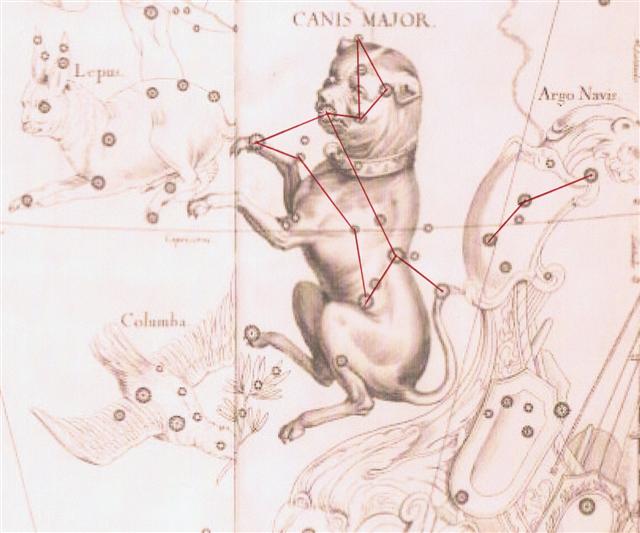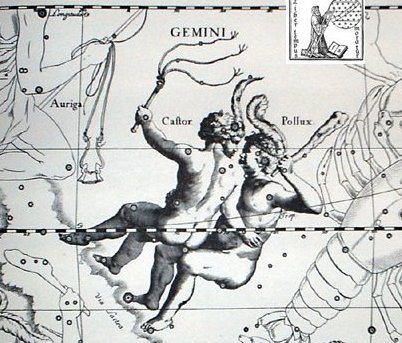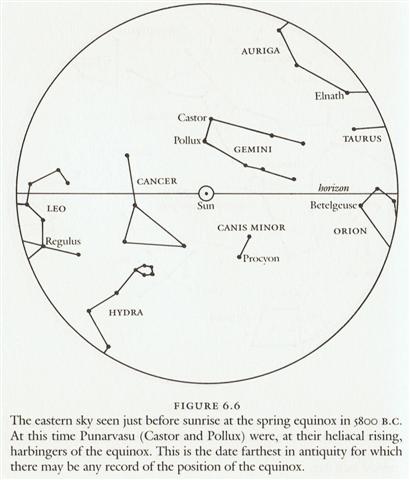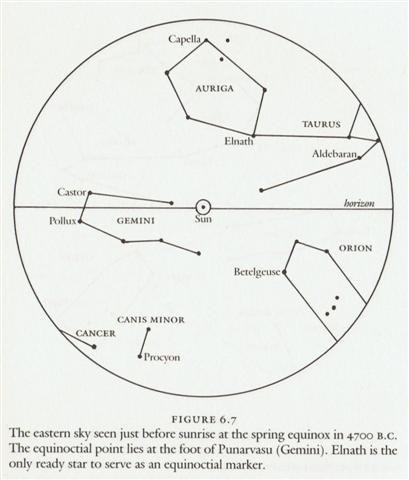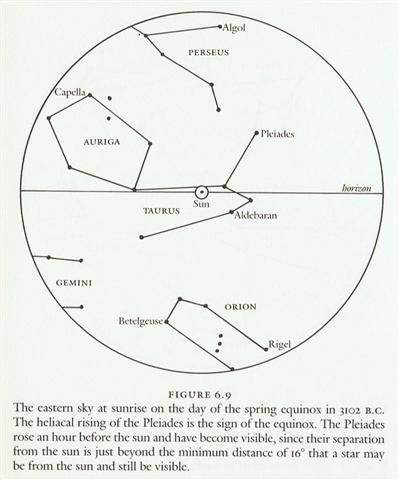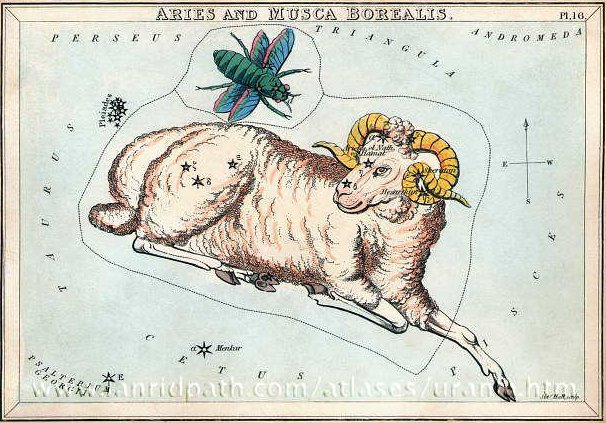The 8th right ascension hour began between the rising (Ka3-1) and descending (Ka3-5) fishes and it ended late in July. The 'heavy-weighing' (ponderosus, el-wezn) star Wezen (δ Canis Majoris) was rising heliacally at the end of 7h. Hevelius has Wezen at the back-bone corner of the Great Dog:
I have named the type of glyph at Castor ihe tau ('point in time') because it probably indicates the ruler has been 'killed' (dethroned): "A vestige of the practice of putting the king to death at the end of a year's reign appears to have survived in the festival called Macahity, which used to be celebrated in Hawaii during the last month of the year. About a hundred years ago a Russian voyager described the custom as follows: 'The taboo Macahity is not unlike to our festival of Christmas. It continues a whole month, during which the people amuse themselves with dances, plays, and sham-fights of every kind. The king must open this festival wherever he is. On this occasion his majesty dresses himself in his richest cloak and helmet, and is paddled in a canoe along the shore, followed sometimes by many of his subjects. He embarks early, and must finish his excursion at sunrise. The strongest and most expert of the warriors is chosen to receive him on his landing. The warrior watches the canoe along the beach; and as soon as the king lands, and has thrown off his cloak, he darts his spear at him, from a distance of about thirty paces, and the king must either catch the spear in his hand, or suffer from it: there is no jesting in the business. Having caught it, he carries it under his arm, with the sharp end downwards, into the temple or heavoo. On his entrance, the assembled multitude begin their sham-fights, and immediately the air is obscured by clouds of spears, made for the occasion with blunted ends. Hamamea (the king) has been frequently advised to abolish this ridiculous ceremony, in which he risks his life every year; but to no effect. His answer always is, that he is as able to catch a spear as any one on the island is to throw it at him. During the Macahity, all punishments are remitted throughout the country; and no person can leave the place in which he commences these holidays, let the affair be ever so important.'" (Sir James George Frazer, The Golden Bough. A Study in Magic and Religion.)
Castor was the mortal of the Gemini twins, in contrast to the immortal Pollux who was rising 3 days later. I think Castor a long time ago represented the winter ('death') half of the year and Pollux the summer ('life') half. 192 is equal to half 13 synodic lunar months. 13 * 29½ / 2 = 191¾. This is probably where in rongorongo times Castor was thought to die. He could have personified the first half of a cycle beginning in Gregorian day 383½ - 365¼ = 18¼, i.e. in January 19 (the on average coldest day of the year north of the equator). January 19 approximately coincides with 20h counted from March 21: 80 + 20h / 24h * 365¼ = 384.375 The elbow ornament - formed like a bivalve (pure) - of the bird in Ka3-7 probably represents a pair of half-year 'shells', i.e. the Castor and Pollux twins according to my interpretation. Castor wields his Cat o' nine tails in contrast to the Club of Pollux:
... At the beginning of 44 B.C. - when Ceasar was still alive - the Senate decided to raise statues of him in all the temples and to sacrifice to him on his birthday in the month Quintilis, which in honour of him was renamed July. He was raised to the status of a god (among the other gods of the state) under the name Jupiter Julius. Marcus Antonius, who this year was consul together with Ceasar, became high priest and responsible for the ceremonies. In the middle of February, at the time of the old feast of Lupercalia, he ran around naked (except for a girdle - like a maro), and whipped the Roman ladies with thongs made from goat-skin, in order to promote ('kick' - Rei), their fertility. Surely there must be some connection with the she-goat Amalthea (Capella) who suckled Zeus. But we cannot repeat all written about her earlier in this investigation. It is enough to remember: ... The Akkadian Dil-gan I-ku, the Messenger of Light, or Dil-gan Babili, the Patron star of Babylon, is thought to have been Capella, known in Assyria an I-ku, the Leader, i.e. of the year; for, according to Sayce, in Akkadian times the commencement of the year was determined by the position of this star in relation to the moon at the vernal equinox ... Instead , to the point: The name of the month February must be based on februa, the name of the whiplashes made from goat-skin ... The Gemini twins are standing on the other side of the Milky Way 'river' compared to Orion, from whom Pollux may have inherited his Club. Hamlet's Mill: "All 'change stations' are found invariably in two regions: one in the South between Scorpius and Sagittarius, the other in the North between Gemini and Taurus; and this is valid through time and space, from Babylon to Nicaragua. Why was it ever done in the first place? Because of the Galaxy, which has its crossroads with the ecliptic between Sagittarius and Scorpius in the South, and between Gemini and Taurus in the North." "Men's spirits were thought to dwell in the Milky Way between incarnations. This conception has been handed down as an Orphic and Pythagorean tradition fitting into the frame of the migration of the soul. Macrobius, who has provided the broadest report on the matter, has it that souls ascend by way of Capricorn, and then, in order to be reborn, descend again through the 'Gate of Cancer'. Macrobius talks of signs; the constellations rising at the solstices in his time (and still in ours) were Gemini and Sagittarius: the 'Gate of Cancer' means Gemini. In fact, he states explicitly (I,12.5) that this 'Gate' is 'where the Zodiac and the Milky Way intersect'. Far away, the Mangaians of old (Austral Islands, Polynesia), who kept the precessional clock running instead of switching over to 'signs', claim that only at the evening of the solstitial days can spirits enter heaven, the inhabitants of the northern parts of the island at one solstice, the dwellers in the south at the other ... Considering the fact that the crossroads of ecliptic and Galaxy are crisis-resistant, that is, not concerned with the Precession, the reader may want to know why the Mangaians thought they could go to heaven only on the two solstitial days. Because, in order to 'change trains' comfortably, the constellations that serve as 'gates' to the Milky Way must 'stand' upon the 'earth', meaning that they must rise heliacally either at the equinoxes or at the solstices. The Galaxy is a very broad highway, but even so there must have been some bitter millenia when neither gate was directly available any longer, the one hanging in midair, the other having turned into a submarine entrance ..." From Capella (α Aurigae, the Leader of the year) to Castor there are 5 weeks:
Castor and Pollux are standing on the brink of the new year, where nature begins anew. So it has been all through the ages: "In Hindu legend there was a mother goddess called Aditi, who had seven offspring. She is called 'Mother of the Gods'. Aditi, whose name means 'free, unbounded, infinity' was assigned in the ancient lists of constellations as the regent of the asterism Punarvasu. Punarvasu is dual in form and means 'The Doublegood Pair'. The singular form of this noun is used to refer to the star Pollux. It is not difficult to surmise that the other member of the Doublegood Pair was Castor. Then the constellation Punarvasu is quite equivalent to our Gemini, the Twins. In far antiquity (5800 B.C.) the spring equinoctial point was predicted by the heliacal rising of the Twins (see fig. 6.6). By 4700 B.C. the equinox lay squarely in Gemini (fig. 6.7).
Punarvasu is one of the twenty-seven (or twenty-eight) zodiacal constellations in the Indian system of Nakshatras. In each of the Nakshatras there is a 'yoga', a key star that marks a station taken by the moon in its monthly (twenty-seven- or twenty-eight-day course) through the stars. (The sidereal period of the moon, twenty-seven days and a fraction , should be distinguished from the synodic, or phase-shift period of 29.5 days, which is the ultimate antecedent of our month.) In ancient times the priest-astronomers (Brahmans) determined the recurrence of the solstices and equinoxes by the use of the gnomon. Later they developed the Nakshatra system of star reference to determine the recurrence of the seasons, much as the Greeks used the heliacal rising of some star for the same purpose. An example of the operation of the Nakshatra system in antiquity can be seen in figure 6.9
Here we see that the spring equinox occurred when the sun was at its closest approach to the star Aldebaran (called Rohini by the Hindus) in our constellation Taurus. But, of course, the phenomenon would not have been visible because the star is too close to the sun for observation. The astronomers would have known, however, that the equinoctial point was at Aldebaran by observing the full moon falling near the expected date or near a point in the sky exactly opposite Aldebaran (since the full moon is 180º from the sun), that is, near the star Antares; see fig. 6.15.
The system of Nakshatras, then, is quite distinct from systems that use the appearance of heliacally rising or setting stars as the equinoctial marker. Furthermore, the Indian system is all but unique in that two calendar systems competed with each other - a civil system, in which the year's beginning was at the winter solstice, and a sacrificial year, which begins at the spring equinox. The beginning of the former was determined by the Nakshatra method, observing the winter full moon's apparition near the point of the summer solstice in the sky (as explained above). The arrival of the beginning of the sacrificial year might be determined by the Nakshatra method - observation of the spring full moon near to the autumn Nakshatra in Virgo. More commonly, however, it was determined as in the Greek system, by direct observation of the heliacal rising of a sign star. In the current calendar, for example - one unchanged since the fifth century A.D. - the yoga star of the Nakshatra Ashvini (beta Arietis) ushers in the spring equinox at its heliacal rising." (Thomas D. Worthen, The Myth of Replacement. Stars, Gods, and Order in the Universe.) In rongorongo times the yoga star of Ashvini (Sheratan, β Arietis) rose heliacally in April 17 = 27 days beyond March 21. April 17 is day 107 in the Gregorian calendar.
By using the nakshatra method of looking at the stars they could on Easter Island have relied on the Gregorian calendar in spite of the fact that winter and summer were reversed. For instance could Minkar determine autumn equinox not because it rose heliacally in September 21 - but because it appeared close to the full moon when it was autumn equinox on Easter Island. |
